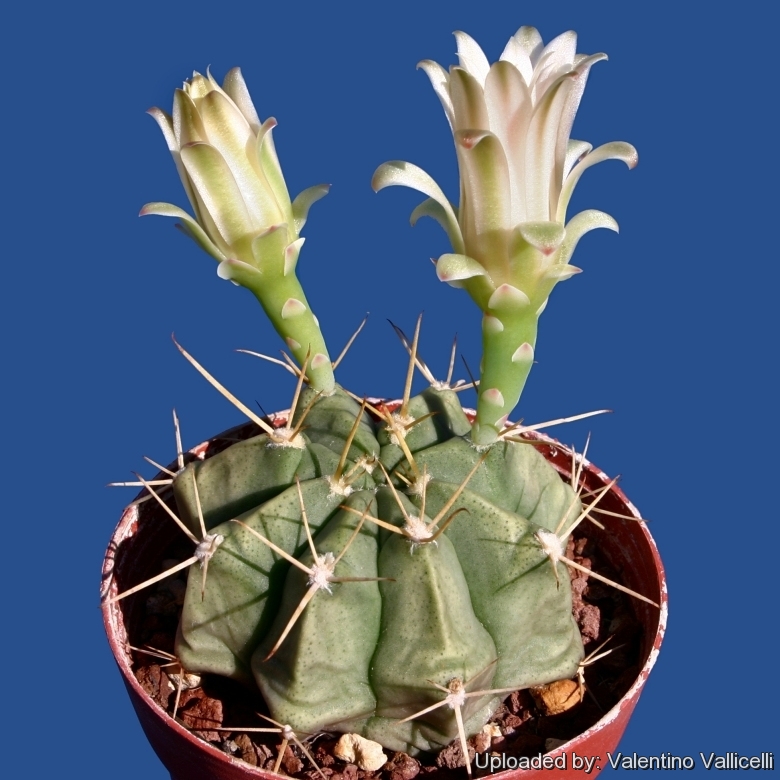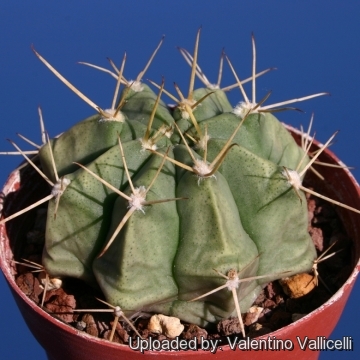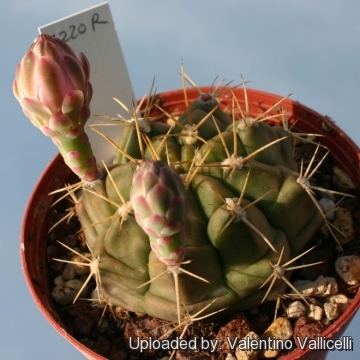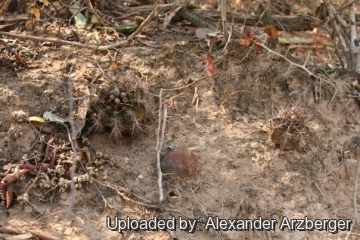




Your support is critical to our success.
Gymnocalycium 16(3): 529 (528; Abb. 15-19). 2003 [Aug 2003]
Family: CACTACEAE
Accepted Scientific Name: Gymnocalycium anisitsii (K.Schum.) Britton & Rose
Cactaceae (Britton & Rose) 3: 159, fig. 168. 1922 Britton & Rose

Origin and Habitat: Santa Cruz (Salinas de San Jose, Cordillera ) Bolivia.
Altitude: 300-400 metres above sea level.
Synonyms:
- Gymnocalycium anisitsii var. griseopallidum H.Till & Amerh.
- Gymnocalycium griseo-pallidum Backeb.
Gymnocalycium anisitsii (K.Schum.) Britton & Rose
Cactaceae (Britton & Rose) 3: 159, fig. 168. 1922
Synonymy: 21
- Gymnocalycium anisitsii (K.Schum.) Britton & Rose
- Echinocactus anisitsii K.Schum.
- Gymnocalycium anisitsii subs. damsii (K.Schum.) G.J.Charles
- Echinocactus damsii K.Schum.
- Gymnocalycium damsii Britton & Rose
- Gymnocalycium anisitsii subs. damsii f. cristatum hort.
- Gymnocalycium anisitsii subs. damsii f. monstruosum hort.
- Gymnocalycium anisitsii subs. damsii f. variegata hort.
- Gymnocalycium anisitsii var. griseopallidum H.Till & Amerh.
- Gymnocalycium griseo-pallidum Backeb.
- Gymnocalycium anisitsii var. tucavocense Backeb. ex H.Till & Amerh.
- Gymnocalycium damsii var. boosii Amerh.
- Gymnocalycium damsii var. centrispinum Backeb.
- Gymnocalycium damsii subs. evae Halda, Horáček & Milt
- Gymnocalycium damsii var. rotundulum Backeb.
- Gymnocalycium joossensianum Britton & Rose
Gymnocalycium anisitsii subs. holdii Amerh.
Gymnocalycium 16(3): 531 (-532; Abb. 23-37). 2003 [Aug 2003]
Accepted name in llifle Database:
Gymnocalycium anisitsii subs. multiproliferum (P.J.Braun) P.J.Braun & Esteves
Succulenta (Netherlands) 74(3): 131 (1995)
Synonymy: 2
- Gymnocalycium anisitsii subs. multiproliferum (P.J.Braun) P.J.Braun & Esteves
Gymnocalycium anisitsii subs. volkeri Amerh.
Gymnocalycium 17(1): 559 (-560; abb. 35-38). 2004 [Feb 2004]
Cultivars (1):
Description: Gymnocalycium griseo-pallidumSN|13315]]SN|13323]] is a small cactus barely rising above ground level, solitary or branching basally in cultivation to form clusters. It differs from Gymnocalycium anisitsiiSN|13323]]SN|13315]] for the paler greyish-green, sharply ribbed stem (usually green and reddish-brown in anisitsii) and for the greenish-white flowers.
Roots: Fibrous roots.
Stem: Spherical-depressed to short cylindrical, up to 10 cm tall, 8-15 cm in diameter, pale greyish-green, pale bluish-green, or pale-brownish-green often with subtle horizontal clear strips.
Ribs: About 10-11, acute, obscurely notched into chin-shape protrusions.
Radial spines: 5-8 up to 12 mm (or more) long, straight or slightly tortuous, short, nearly useless in terms of defence. Young spine are pastel-white or yellowish with a darker tip, later become pale-grey.
Central spines: Usually absent.
Flowers: From the centre, narrow, funnelform, about 6 cm long. External tepals greenish whit reddish margins, internal tepals greenish-white often suffused with pink, spreading. Scales on the ovary and flower tube small, pink and scattered.
Blooming season: It produces flowers almost continuously during the year.
Fruits: Oblong, 2,5 cm long, 6 mm in diameter, reddish at maturity.
Subspecies, varieties, forms and cultivars of plants belonging to the Gymnocalycium anisitsii group
Gymnocalycium anisitsii is a very polymorphic species with a large range of variability. Two subspecies are recognized, the nominate form and subsp. multiproliferum. There seems to be very little justification for vars. centrispinum, rotundulum, torulosum and tucavocense. Gymnocalycium griseopallidum from the salt-pan desert area on the Bolivia-Paraguay borders may well be another variety or local form which has become adapted to the peculiar local conditions of that region.
 Gymnocalycium anisitsii (K.Schum.) Britton & Rose: may be solitary or freely offsetting with white flowers. Spines 5 to 7, tortuous, up to 6 cm. long. It is a very polymorphic species with a large range of variability. Distribution: Bolivia, Paraguay.
Gymnocalycium anisitsii (K.Schum.) Britton & Rose: may be solitary or freely offsetting with white flowers. Spines 5 to 7, tortuous, up to 6 cm. long. It is a very polymorphic species with a large range of variability. Distribution: Bolivia, Paraguay. Gymnocalycium anisitsii subs. damsii (K.Schum.) G.J.Charles: has stems to 10 cm tall, 8-15 cm in diameter, green to brownish-green, often with horizontal strips. Ribs broad to acute, and more or less notched. Distribution: Bolivia, Paraguay and Brazil.
Gymnocalycium anisitsii subs. damsii (K.Schum.) G.J.Charles: has stems to 10 cm tall, 8-15 cm in diameter, green to brownish-green, often with horizontal strips. Ribs broad to acute, and more or less notched. Distribution: Bolivia, Paraguay and Brazil. Gymnocalycium anisitsii subs. damsii f. cristatum hort.: crested form. Various clones. Garden origin.
Gymnocalycium anisitsii subs. damsii f. cristatum hort.: crested form. Various clones. Garden origin. Gymnocalycium anisitsii subs. damsii f. monstruosum hort.: monstrous form. Various clones. Garden origin.
Gymnocalycium anisitsii subs. damsii f. monstruosum hort.: monstrous form. Various clones. Garden origin. Gymnocalycium anisitsii subs. damsii f. variegata hort.: variegated form. Various clones. Garden origin.
Gymnocalycium anisitsii subs. damsii f. variegata hort.: variegated form. Various clones. Garden origin. Gymnocalycium anisitsii var. griseopallidum H.Till & Amerh.: has paler greyish-green, sharply ribbed stem and greenish-white flowers. Distribution: Santa Cruz (Salinas de San Jose, Cordillera ) Bolivia.
Gymnocalycium anisitsii var. griseopallidum H.Till & Amerh.: has paler greyish-green, sharply ribbed stem and greenish-white flowers. Distribution: Santa Cruz (Salinas de San Jose, Cordillera ) Bolivia.- Gymnocalycium anisitsii subs. holdii Amerh.
 Gymnocalycium anisitsii subs. multiproliferum (P.J.Braun) P.J.Braun & Esteves: has numerous violet-green stems, longer spines, and rose-colored flowers. Distribution Mato Grosso do Sul, Brazil.
Gymnocalycium anisitsii subs. multiproliferum (P.J.Braun) P.J.Braun & Esteves: has numerous violet-green stems, longer spines, and rose-colored flowers. Distribution Mato Grosso do Sul, Brazil. Gymnocalycium anisitsii var. tucavocense Backeb. ex H.Till & Amerh.: has beautiful deep mauve to violet flowers, is remarkably prolific in branching and very precocious flowering.
Gymnocalycium anisitsii var. tucavocense Backeb. ex H.Till & Amerh.: has beautiful deep mauve to violet flowers, is remarkably prolific in branching and very precocious flowering. Gymnocalycium anisitsii var. tucavocense cv. Red Form: it is a garden selection characterized by an unusual bright red colouring of the body, this colour is due to a reduced production of chlorophyll pigments.
Gymnocalycium anisitsii var. tucavocense cv. Red Form: it is a garden selection characterized by an unusual bright red colouring of the body, this colour is due to a reduced production of chlorophyll pigments.- Gymnocalycium anisitsii subs. volkeri Amerh.
 Gymnocalycium damsii var. boosii Amerh.: has longer, thin, flexible usually twisted spines up to 6 cm long. Flowers bright pink or carmine-red. Distribution: S-E of Chocis, Santa Cruz, Bolivia.
Gymnocalycium damsii var. boosii Amerh.: has longer, thin, flexible usually twisted spines up to 6 cm long. Flowers bright pink or carmine-red. Distribution: S-E of Chocis, Santa Cruz, Bolivia. Gymnocalycium damsii var. centrispinum Backeb.: has 7 radial spines and one long needle-like central spine to 2 cm long. The flowers are white. Distribution: Bolivia, in the vicinity of Roboré.
Gymnocalycium damsii var. centrispinum Backeb.: has 7 radial spines and one long needle-like central spine to 2 cm long. The flowers are white. Distribution: Bolivia, in the vicinity of Roboré.- Gymnocalycium damsii subs. evae Halda, Horáček & Milt
 Gymnocalycium damsii var. rotundulum Backeb.: it is characterized by rounder and scarcely raised tubercles. Distribution: Bolivia, Brazil & Paraguay.
Gymnocalycium damsii var. rotundulum Backeb.: it is characterized by rounder and scarcely raised tubercles. Distribution: Bolivia, Brazil & Paraguay.- Gymnocalycium damsii var. torulosum Backeb.
 Gymnocalycium damsii cv. Purple Blush: has purple blushed stems and nice pink blooms. It seems related to Gymnocalycium damsii var. tucavocense to which it shares many characteristics.
Gymnocalycium damsii cv. Purple Blush: has purple blushed stems and nice pink blooms. It seems related to Gymnocalycium damsii var. tucavocense to which it shares many characteristics.
Bibliography: Major references and further lectures
1) Edward Anderson “The Cactus family” Timber Press, Incorporated, 2001
2) James Cullen, Sabina G. Knees, H. Suzanne Cubey "The European Garden Flora Flowering Plants: A Manual for the Identification of Plants Cultivated in Europe, Both Out-of-Doors and Under Glass" Cambridge University Press, 11/Aug/2011
3) David R Hunt; Nigel P Taylor; Graham Charles; International Cactaceae Systematics Group. "The New Cactus Lexicon" dh books, 2006
4) N. L. Britton, J. N. Rose “The Cactaceae. Descriptions and Illustrations of Plants of the Cactus Family.” Volume 4, The Carnegie Institution of Washington, Washington 1923
5) Curt Backeberg “Die Cactaceae: Handbuch der Kakteenkunde” Gustav Fischer Verlag, Stuttgart New York 1982–1985
6) E. W Putnam “GYMNOCALYCIUMS: A Guide for Growers” National Cactus & Succulent Society. Handbook No. 5. 1978

Gymnocalycium anisitsii var. griseopallidum Photo by: Valentino Vallicelli

Gymnocalycium anisitsii var. griseopallidum Photo by: Valentino Vallicelli

Gymnocalycium anisitsii var. griseopallidum Photo by: Valentino Vallicelli

Gymnocalycium anisitsii var. griseopallidum Photo by: Alexander Arzberger
| Your Actions | |
|---|---|
| Back to Gymnocalycium index | |
| Back to Cactaceae index | |
 |
Back to Cacti Encyclopedia index |
Privacy stantement - Terms and conditions - How to cite - About us - Feedback - Donate



